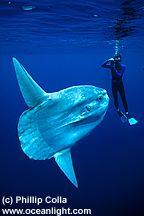
Order: Tetraodontiformes
Family: Molidae
Genus & Species: Mola mola
APPEARANCE
The ocean sunfish looks a bit like a huge lima bean with its round and flat
body. Its body, shaped like a millstone, appears to be part of the head, and
so is often called the "headfish". It is also called the "moonfish" after its
round appearance.
The ocean sunfish has an oval body that is flat and covered with thick,
leathery, scaleless skin protected by a layer of mucous. It is grey,
olive-brown, or nearly black with silvery reflections. Its fins are dark. It has
a small mouth with a snout that projects beyond it. Its teeth on both top
and bottom jaws are fused together to form a single, sharp-edged beak. It
has large and high anal and dorsal fins. Its body ends in a low tail fin that is
short and wavy.
The ocean sunfish may grow to be 11 feet in length, and can weigh two tons.
The ocean sunfish is taller than it is long (fins included).
The ocean sunfish has a small brain: a 200 kg specimen may have a brain
the size of a nut. It has a spinal cord 1/2 of an inch long.
HABITAT
Ocean sunfish are found in most of the world's tropical and temperate
waters. They are usually found along the coastal areas where wrasse and
gulls can rid them of parasites.
FOOD
Ocean sunfish eat crustaceans, starfish, jellyfish, sponges, mollusks, algae,
plankton, squid, and small fish. They will eat basically anything. To eat, the
ocean sunfish will slurp in food through its beak, shred the food to pieces,
spit it out, and then repeat the process until the food is small enough for it
to swallow.
ENEMIES
Ocean sunfish have few enemies. They are preyed upon by great white
sharks, orcas, and sea lions. Sea lions will attack them ferociously, throwing
them in the air like a Frisbee.
Man is another enemy. They mainly hunt ocean sunfish for sport, although
this can be hard as the skin is so tough a Manchester rifle even has trouble
penetrating it. They are eaten in Europe and Japan and their liver oil is of
some importance, but they have never been hunted commercially.
Their tough skin is covered with parasites. Gulls, wrasse, and othe fish rid
them of the external pests.
SWIMMING
Ocean sunfish wave anal and dorsal fins in unison from side to side in order
to move, twisting them slightly as they wave. The pectoral fins wave
continually, but are probably just stabilizers. The tail is used as a rudder. In
order to steer, the ocean sunfish will squirt a strong jet of water out of its
mouth or gills. They are lazy swimmers, sometimes letting the current carry
them. Occasionally, the current will carry them into cold water, where they
die. When need be, they can dart quickly through the water. They can jump
10 feet into the air and can dive to depths of 600 feet.
BREEDING
Ocean sunfish are the most fertile of saltwater fish, being able to lay up to
300 000 000 eggs at a time. When, where, and how they mate is a mystery.
When born, the larvae look like regular fish at 1/10 of an inch in length.
The dorsal and anal fins then begin to grow and the body becomes covered
with spines. These spines are then lost with only 5 remaining. These last 5
spines shorten until they disappear. Once they are gone, the bulky,
disc-shape body begins to form. At this time the baby fish is only 1/2 of an
inch long.
RELATIVES
The ocean sunfish is not related to freshwater sunfish. It is closely related to
the pufferfish. The sharptail sunfish, slender sunfish, and southern ocean
sunfish are the only other three fish in the family Molidae.